A fascination with double-barrel nitro express big-game rifles gripped me in 1974 for foot stalking wild Water Buffaloes in the Northern Territory.
By 1980 I was in deep collaboration with Geoff McDonald in his development of his line of Woodleigh Bullets. Holland & Holland double rifles from India were then affordable and along with other English makers could be loaded for Water Buffalo hunting with Woodleigh Bullets and Bell (of U.S.A.) brass.
The availability of a Holland & Holland Royal 12 bore waterfowl shotgun from India inspired an interest in English double shotguns and wingshooting waterfowl on Northern Territory wetlands. Double rifles were historically scant on the Australian traditional firearms scene,
before the 1970's flood of Indian imports from the Raj. Double shotguns, however, were prominent throughout the period of Australian Colonial settlement to modern times, from muzzleloaders to modern over & unders.
No factory records for William Cashmore have surfaced...
An association with buffalo hunters, using mostly Indian origin big-game rifles, exposed me to farmers and rural area people who had grown up with shotguns and quail and duck shooting. I cannot recall why I developed a 'special' interest in William Cashmore products though. Tony Moodie of Hedgely Trading in Melbourne was big in importing English firearms from India, followed by John Saunders and Wal Winfer, also in Melbourne.
There were also other importers from Perth in Western Australia & Queensland. I purchased a heavy Cashmore; a plain quality Cashmore hammer gun, damascus, but original nito proof and well finished, in good original condition in 1987 from John Saunders, which may mark my earliest Cashmore acquisition. It had serial number 13065,was of post 1907 manufacture and made by Walter Betts for Cashmore.
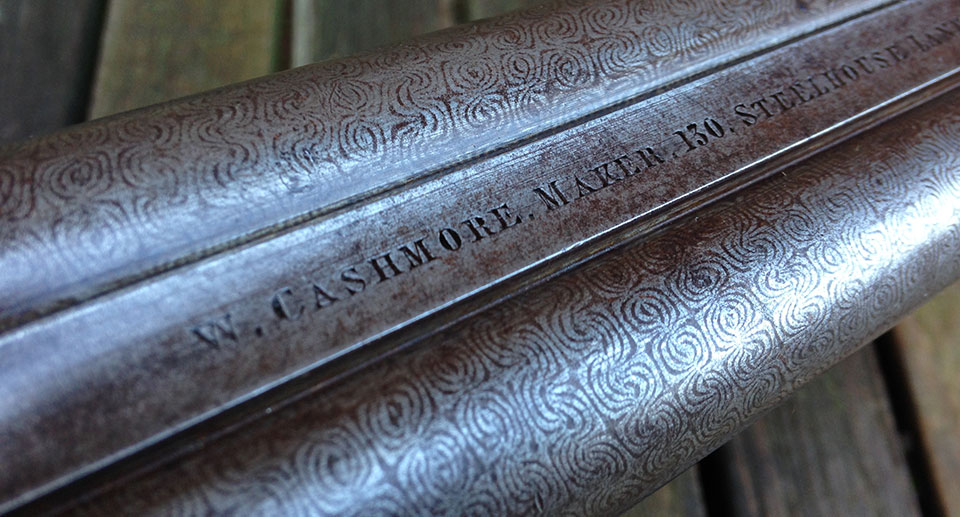
No factory records for William Cashmore have surfaced to my knowledge but the dating of guns is well served by the interpretation of information engraved on individual guns. As with all English guns Cashmores carry proof marks with changes in proof marks (when Rules of Proof were updated periodically) giving evidence of the date of the original proof, within the years that different marks were valid.
often sourced from Birmingham suppliers to the trade
Cashmore serial numbers mostly comply with a sequence in one series only from the early 1880's, through to post WW1. Cheap plain guns, often sourced from Birmingham suppliers to the trade but sold as Cashmore guns, through to best quality guns made by Cashmore, share the same Cashmore sequence of serial numbers.
A unique quality (feature) of better quality Cashmores is the inscribing on the barrels of the firm's success at exhibitions in Australia and New Zealand, with the year of exhibition inscribed alongside the location of exhibition. Guns so inscribed, therefore, date from after the latest exhibition year on the barrels. Finally, the ownership records for an individual gun occasionally pinpoints manufacture and delivery dates for that gun.
The apparent chronological reliability of the serial number sequence allows cross calculations to estimate a gun's date of manufacture, using the available data. My chronology is derived from guns in my possession, published information on Cashmores and pursuit of all information obtainable from guns brought to my attention from other owners.
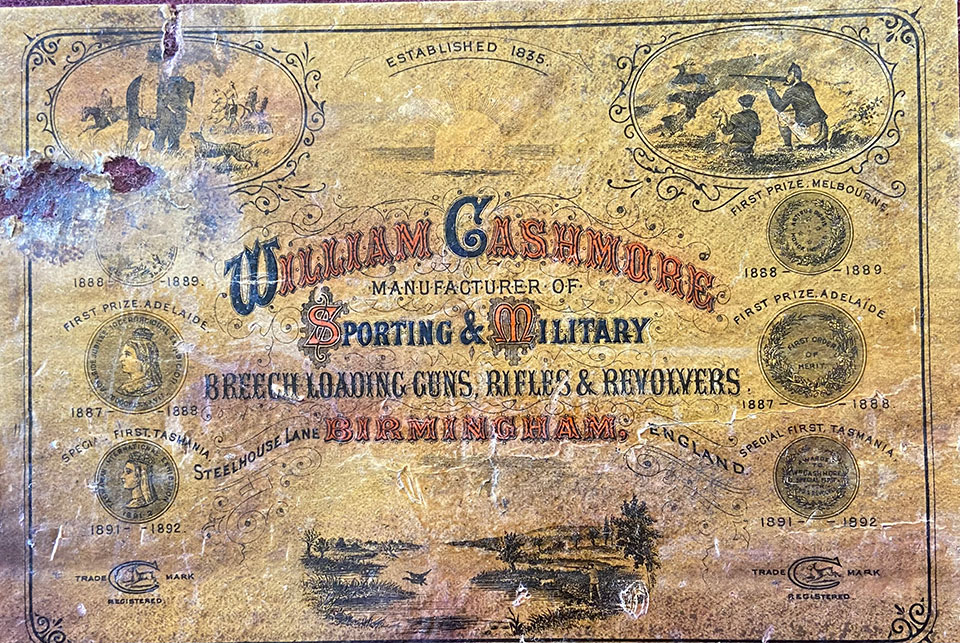
Published information includes articles in journals and auction catalogue descriptions. A good review of the history of 'William Cashmore' is available by Douglas Tate in "Birmingham Gunmakers" (Safari Press). I have a medium grade percussion double barrel 12 bore in good condition with no serial number and 'W. Cashmore London' engraved on the barrels, "W.C." inside each lock and Birmingham proof marks. I have seen a photo of another similar grade Cashmore in Australia. The three Cashmore records presented here commence with guns proofed prior to 1887 changes to proof marks.
(1) S/N 4017 of pre 1886. It has original pre-1887 12-bore barrels, damascus with W.C. stamped below each barrel. Cashmore shield escutcheon ahead of heel on stock. Cashmore type Anson release forend. Action is W.W. Greener Facile Princeps with Greener 'Elephant' trade mark. The gun came with post 1888 16 bore barrels with 'M' on the forend loop, sound condition.
(2) S/N 4233 of pre 1886.
Next is Anson & Deeley boxlock non ejector Cashmore number 4233, in poor condition. Pre 1887 proof, a medium grade Cashmore made gun on a trade supplied action, 12 bore.
(3) S/N 4613 of pre 1886.
An exhibition grade Anson & Deeley ejector gun, 12 bore 'BARRE' engraved. Cashmore stock escutcheon and running Rabbit trademark on forend iron. Although barrels, action & ejector work is clearly 'Westley Richards', this gun probably secured exhibition wins for Cashmore at the Adelaide Exhibition of 1887/88.
S/N 5810 of 1889, Cashmore model 130, a pigeon hammer gun, Highest awards Adelaide 1887, Melbourne 1888, a high grade gun.
Most Cashmore shotguns from the 1880's on, use the same serial number range with my observations commencing with 4017 and concluding with 20665 with post 1925 proof marks. Within that period many guns recorded Cashmore's success at exhibitions in Australia between 1887 and 1895 and then at Christchurch, New Zealand in 1907, with the highest award locations and dates engraved on the barrels, or on Cashmore's letter heads. The proof marks on each gun also indicate a period when the gun was made, being within the period that proof marks were in use and valid.
Patent dates may also indicate a date after which a gun was made. A percussion 12 bore Cashmore in my possession is all original but has no serial number!
Cashmores 4017, 4233, & 4613 date from pre-1887, according to proof marks. Cashmore 4896 has 'Highest Award Adelaide 1887' on the barrels, so dates from 1888 or 1889. Cashmores 5170, 5810, 5847, 5990, 6280, 6300, 6674, 7163 & 7177 carry 'Awards for Adelaide 1887' and 'Melbourne 1888'. I should mention the actual wording on the gun may be "First Prize" or "Highest Award"; the important message is the place and year of the award.
Cashmore produced modern guns of the highest quality
Although Australia was connected with the U.K. by cable, I treat the award year as a year before the earliest award carrying guns were completed. A gun carrying 'First prize Adelaide 1887, Melbourne 1888' would probably have been completed between 1889 and 1892.
In 1892, Cashmore exhibited successfully in Launceston, Tasmania. This success was recorded on barrels as "Tasmania". In 1895 Cashmore was again successful at Hobart in Tasmania and guns thereafter identified the 1892 'Tasmania' award as "Launceston" & the 1895 award as "Hobart". This has led to confusion in dating some guns. For example, the James Julia auction catalogue of October 2016 described 'Annie Oakleys' Cashmore 9270 as 'circa 1893'. However, 9270 carries notification of the Hobart award, which dates the gun to 1895 or possibly 1896.
With the guns 5170 to 7177 falling between 1889 and 1892, the next series of Cashmores carry 'Highest Awards Adelaide 1887, Melbourne 1888, Tasmania 1892' on their barrels. Guns so inscribed run from 1892 or 1893 through to 1895, and include guns 7411, 7784, 8088, 9083.
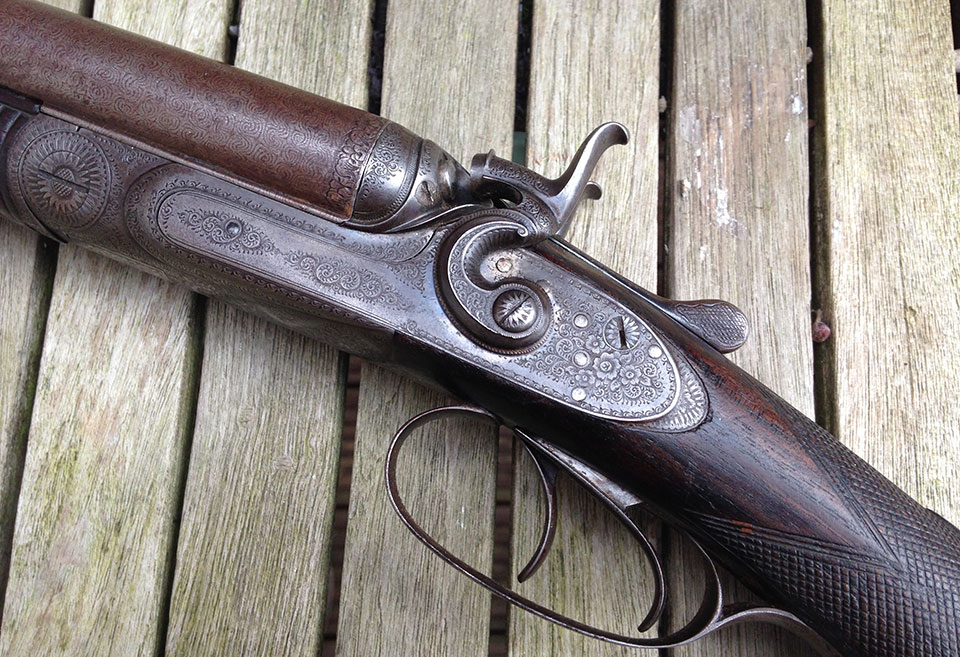
Gun numbers up to 8088 (inclusive) are Birmingham pre-nitro proof (black powder proof). No.9083 is a 'Nitro' patent model, possibly Nitro No.1 and is proofed for 50gn Schultz smokeless powder; and survived this!
The period from the 1895 Hobart award through to 1907 Christchurch award might be seen as the period in which Wm. Cashmore produced modern guns of the highest quality with uniquely Cashmore designs. Serial numbers for this period run from 9270 (Annie Oakley's Cashmore), 9303, 9740, 10043, 10329 (Tom Marshall's Cashmore), 10330, 10518, 10519, 10960.
Also, 10378 featured in an interesting D.G.J. (Double Gun Journal) article in spring 2019 giving full manufacture and delivery history.
At some point between 1904 and 1907 or soon after 1907 Cashmore stopped making high grade guns of their unique patterns that had evolved through the 1890's.
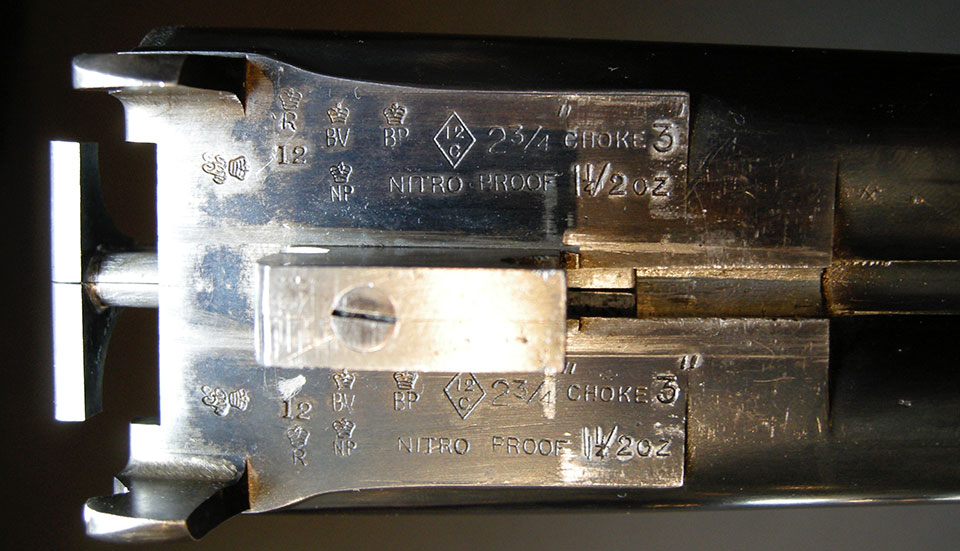
Two high grade sidelock pigeon guns, 13978 & 14899 carry the Christchurch award of 1907 on the barrels. Sidelock ejector 13978 32" Whitworth dovetail barrels may have Scott or F.C. Scott action and barrel work with furniture locks and stocking of Cashmore style.
30" Whitworth dovetail barrel sidelock non-ejector 14899 has a G & S Holloway best sidelock action but, again, has a Cashmore trigger guard and stock style. It is absolute BEST quality. Subsequent lesser grade guns appear to be F.C. Scott model 180 replicas and post 1925 B.L.N.E. No.20606 is a medium grade Holloway & Naughton replica essentially identical to standard Boswell guns from that and earlier periods.
Cashmore introduced its NITRO patents gun for shooting heavy charges...
While the exhibition grade Cashmore No.4613 of 1886 is basically all Westley Richards in barrels, action and ejector work, from 1887 Cashmore guns incorporated Cashmore's qualities not used by other makers. The Cashmore hammer pigeon guns, models 130A, 130B, and 131 were high-grade guns popular in Australia from 1888 through to 1892 or later.
The large bottom short barrel rib with integral forend loop appears on these guns and was a feature of better grade pigeon and wildfowl guns through to post-1900, including Nos.10518 and 10519. In the early 1890's it was copied in a slightly smaller profile by Webleys on their double rifles for obvious benefit to forend securing to barrels, under heavy recoil.
Forend iron work is secured to the forend wood by screws (pins) bedded in a characteristic circular base in the forend in good Cashmores. A shield escutcheon is usually, not always, located on top of the stock near the heel. After 1895 the rear of the trigger guard was noticeably thickened in BEST Cashmores similar to John Rigby doubles.
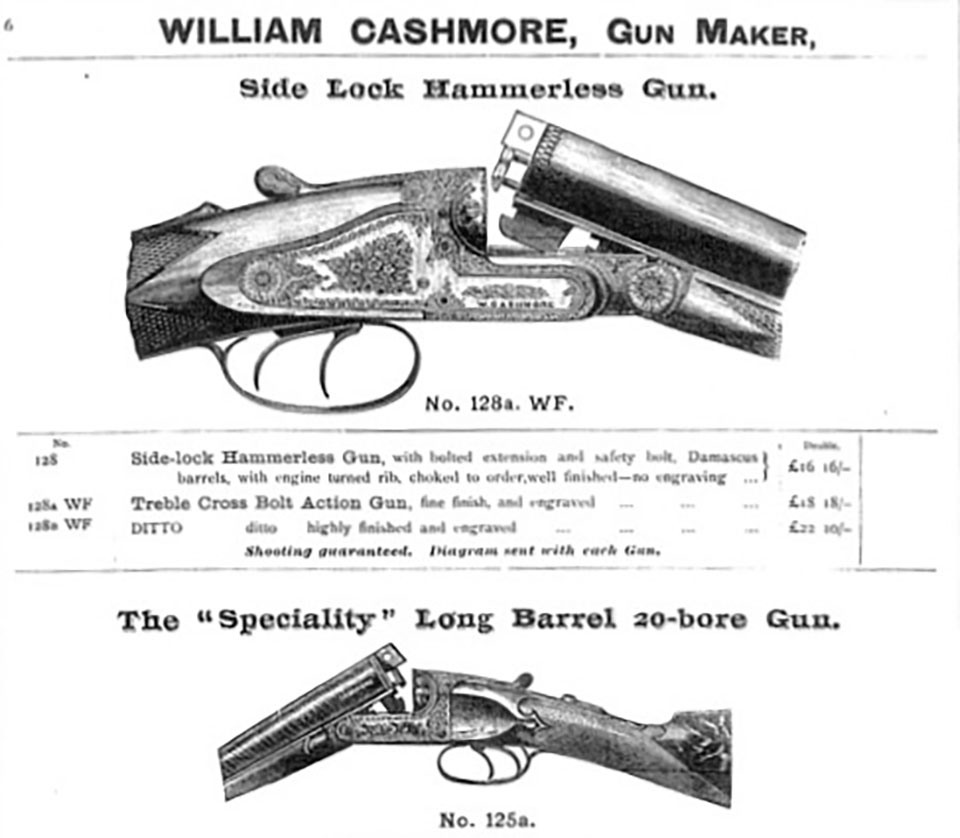
Cashmore used actions from other makers through to 1895. Medium grade boxlock pigeon gun 7177 is based on a Holloway & Naughton action of a design essentially unchanged by Holloway & Naughton through to 1954. Although the gun is pre-nitro proof it has Cashmore pattern Whitworth barrels and of five similar Holloway & Naughton made guns, 7177 is the finest.
No.6280 is a boxlock non ejector cased with original 2 sets barrels based on a Westley Richards supplied action on the Anson & Deeley 2nd patent. The barrels are one set damascus and little used, the other set is Whitworth steel with chokes cut off , well used & now 30" cylinder bored. A BEST gun.
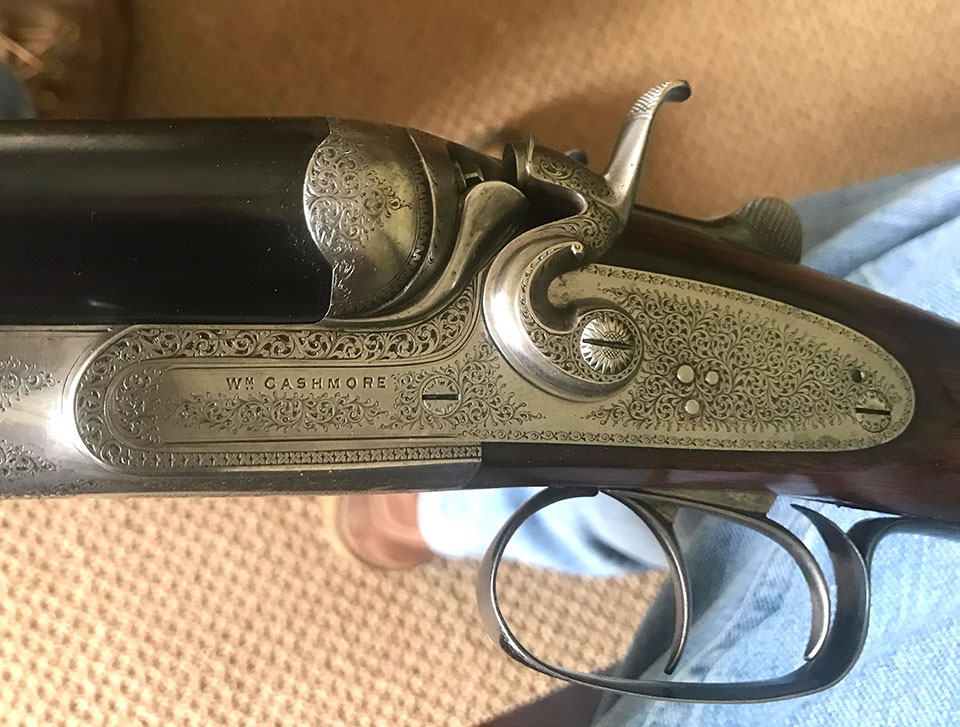
Sidelock cased two barrel set BEST guns Nos.6674 and 8088 are both based on modified Scott actions with Rogers cocking replacing Perkes cocking. Both are non-ejectors. Apart from Scott-based actions these guns are all Cashmore throughout, again with original 32" Whitworth barrels and 32" damascus barrels.
The damascus barrels of No.6674 have been cut to 30" and replacement left barrel by William Lee fitted between 1904 and 1907 and nitro proofed. No.6674, although BEST quality, is a nickel-plated action with no engraving. No.8088 has exceptional bouquet and scroll engraving, a feature of BEST Cashmores through 1904.
Holloway & Naughton also had guns engraved by these unknown Birmingham craftsmen and their work is often seen on typical Naughton-supplied boxlocks & sidelocks of the period. This bouquet & scroll is of unexcelled quality!
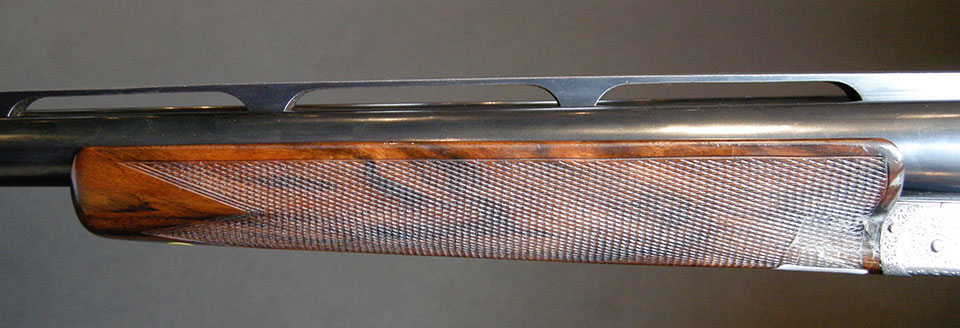
From 1894 -1895 Cashmore introduced its NITRO patents gun for shooting heavy charges of smokeless powder and shot. Original Mills patent NITRO guns had damascus barrels but the development of the NITRO gun, incorporating a second patent by Cashmore, saw the use of solid lump (chopper lump) Whitworth steel barrels emerge.
At this time, Cashmore introduced modern boxlock and sidelock ejector guns of BEST quality, apparently to Cashmore's own design.
The only guns with similar external lines I've seen illustrated are by William Ford. All Cashmore BEST trap guns, boxlocks and sidelocks in model 127C & NITRO guns, featured chopper-lump, Whitworth barrels with the massive Cashmore short bottom barrel rib.
Strangely, most NITRO guns have Harvey forend fasteners while boxlocks and sidelocks have Anson push-down button forends release which is superior to the Harvey. Through the evolution of fine quality Cashmore guns the main production of Cashmores was plain grade in Australia as rural use guns mostly plain sound hammerguns. Prices ran from GBP£4 to GBP£15 in 1904, then up to GBP£30 for higher but not best quality. Anson & Deeley hammerless sidelocks in plain quality ran at around GBP£20 and up.
95% of Cashmores in Australia were of these plainer qualities
I would suggest 95% of Cashmores in Australia were of these plainer qualities and often supplied to Cashmore from other makers, if often finished by Cashmore. Champion trap shooter Donald Macintosh mentions visiting the factory of William Cashmore around 1900.
I know of no other reference to the Cashmore works.
The Mills (1894) and Cashmore (1895) patent NITRO GUN was popular in Australia, although costing the same as a London BEST in price! My NITRO, serial number 9303, is Cashmore 1895 patent use No 11, although predating the main NITRO gun production period 1896 through to 1900.
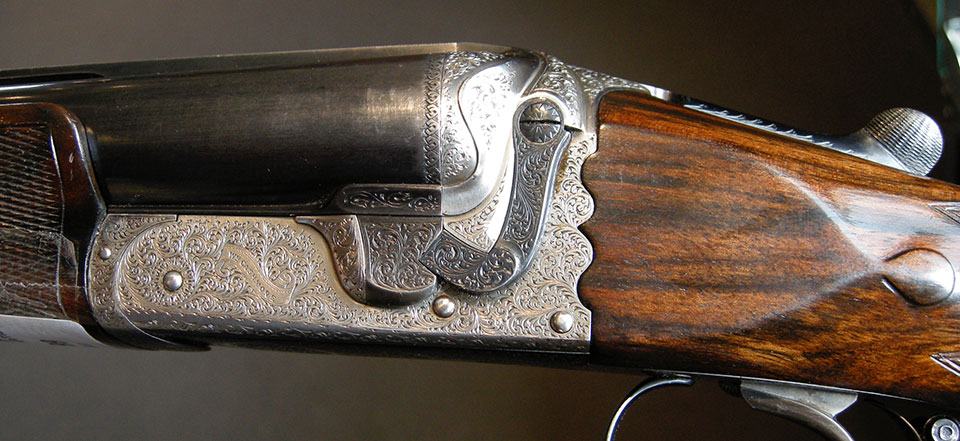
No.9303 is not smokeless nor nitro proofed, unlike earlier No.9083, nor is Annie Oakleys No.9270. Greener gives a clear account of the hazard of submitting guns for smokeless proof prior to the adoption of standard nitro proof loads using black powder propellant by London & Birmingham proof houses in 1896. Proof house overloads of smokeless powder for proof purposes destroyed sound guns, hence Cashmore settling for old black powder proofing for early smokeless or NITRO guns.
In Australia, Cashmore NITRO guns probably outsold Purdey's during their production run, 1895 through 1900.
Cashmore guns and records in my possession provide a good indication of gun production dates from 1886 or earlier through to 1904.
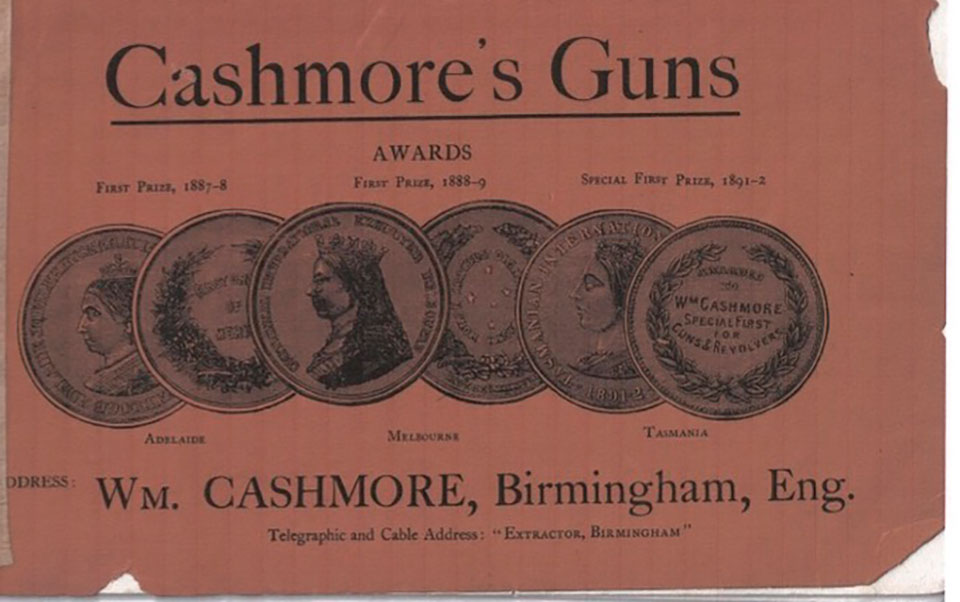
NOTES
Additional information would be invaluable to Cashmore students & appreciators.
Any correspondence to, Dave Lindner, P.O. Box 114, Jabiru, N.T., 0886, Australia, will be acknowledged & answered."
Written by David A. Lindner.
Published by Vintage Guns Ltd on (modified )




